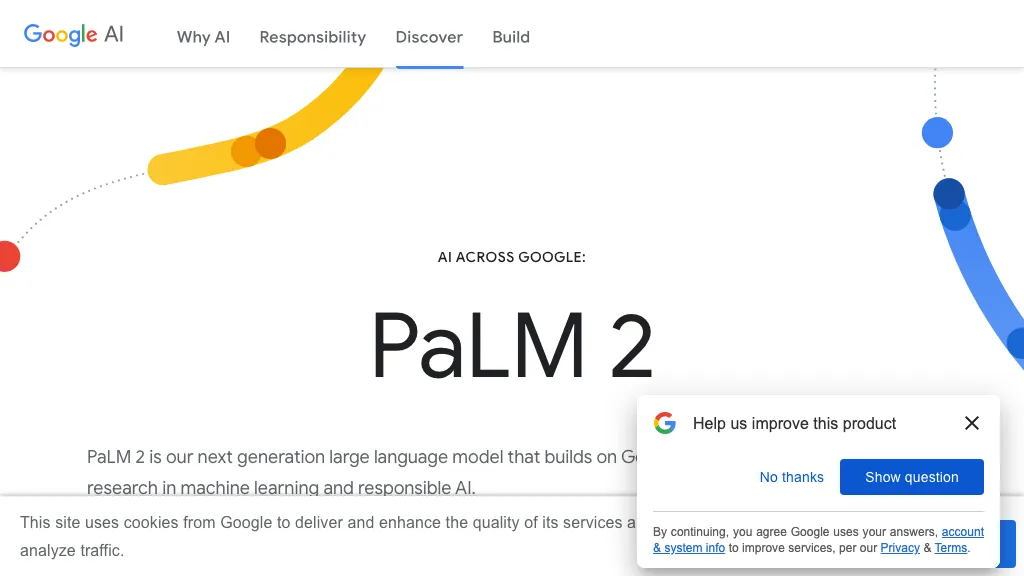What is PaLM 2?
Google AI’s PaLM 2 is a next-generation LLM developed to achieve state-of-the-art performance on advanced reasoning tasks like code math, classification, question answering, translation, and natural language generation. In keeping with the aim of responsible AI, PaLM 2 is designed, developed, and tested to ensure rigorous standards in the mitigation of potential harms and biases. The model was pre-trained on a mix of texts including multilingual data, programming languages, mathematical expressions, scientific publications, and web pages; therefore, it is much more robust on many dimensions. By scaling compute-optimal scaling better dataset mixture and architecture update, PaLM 2 yields state-of-the-art results on many reasoning benchmarks, as well as multilingual translation capabilities and toxicity classification.
Key Features & Benefits of PaLM 2
Consequently, PaLM 2 offers a wide range of features and benefits, making it preferred in various applications, including:
-
Large Language Model:
Most complex model that has been seen so far, which understands and produces human-like text. -
Advanced Reasoning Tasks:
Performs complex problem-solving with advanced logical reasoning. -
Code Math:
Usefulness in solving mathematical equations and code-related problems. -
Classification:
Capable of classifying data with very high efficiency and correctness. -
Question Answering:
Providing answers to questions with precise and relevant information. -
Translation:
Supports multilingual translation tasks with high accuracy. -
Natural Language Generation:
Generates coherent and contextually fitting text.
Benefits related to PaLM 2 include increased productivity, collaboration, especially via tools like the Bard Palm API. Another benefit is that this API offers a range of developer resources to learn about and experiment with generative AI use cases that drive innovation and creativity.
How PaLM 2 Works and Applications
PaLM 2 can apply in many different areas, making big differences in productivity and collaboration:
-
Supercharging Collaboration and Productivity:
Through the Bard Palm API, PaLM 2 amplifies collaboration and productivity. -
Multilingual Translation:
Solves multilingual translation tasks with high accuracy and speed. -
Toxicity Classification:
This model will help detect and classify harmful content to make interactions much safer. -
Question Answering:
Quickly and accurately answers questions coming from users for better information retrieval. -
Code Math and Classification:
Do challenging mathematics and classify code smoothly.
It finds a lot of applications in research, data science, software development, business analysis, and content creation. It also provides immense value in many other industries.
Accessing PaLM 2
To begin using PaLM 2, just follow these simple steps:
-
Access:
Begin by accessing the Bard Palm API to enable the functionality of PaLM 2. -
Experiment and Learn:
Take full advantage of the resources provided to learn and experiment with generative AI. -
Feature Implementation:
Incorporate all kinds of advanced reasoning, translation, and classification functionalities in your projects. -
Scaling and Optimization:
Use compute-optimal scaling for better efficiency and performance of your applications. -
Best Practices:
Keep guidelines of responsible AI usage in mind at all times, reassessing the model constantly with respect to potential biases and harm.
How PaLM 2 Works
PaLM 2 is based on an advanced technical stack composed of:
-
Pre-training:
It was pre-trained on a very diverse mixture of multilingual texts, programming languages, mathematical equations, scientific papers, and web pages. -
Compute-Optimal Scaling:
A scaling technique developed to give the model higher performance. -
Updated Architecture:
The model takes its inspiration from the latest architecture in AI, enabling it to reason better and generate more.
The input given to the model may be of varied types, after which it undergoes several algorithms and models to produce contextually relevant yet accurate output.
PaLM 2: Pros and Cons
While PaLM 2 has numerous advantages, there are certain limitations too:
Pros:
- Best-in-class performance in reasoning and translation.
- Good applicability across most industries.
- Facilitates multilingual functionality and classification with high accuracy.
Cons:
- For a new user, it is difficult to understand the model and integrate it.
- There could be potential biases that one should continuously consider and adjust.
In general, user feedback points at how effective PaLM 2 is and how versatile it would prove; there’s just an initial learning curve some users say exists.
Conclusion about PaLM 2
Conclusion: Google AI PaLM 2 is impressive, capable, and a very large language model. It is supreme in all those areas that require high reasoning ability. This large-scale application makes it a vital tool in any industry. Its disadvantages include initial disadvantageous situations which involve understanding the model and integrating it into a business. These minor setbacks are easily overcome by the advantages. This in itself will increase its power, hence strength, as updates and enhancements are bound to make it even more capable in the times to come for AI applications.
PaLM 2 FAQs
-
What is the PaLM 2?
PaLM 2 is a state-of-the-art large language model developed by Google AI that has been specifically designed to perform a number of advanced reasoning activities: Code Math, Classification, Question Answering, Translation, and Natural Language Generation. -
Who uses PaLM 2?
It finds applications for AI researchers, data scientists, developers, business analysts, and content creators, amongst others. -
How do I get started with PaLM 2?
In an effort to get started with the use of PaLM 2, one needs to gain access to the Bard Palm API and work on learning from available resources, after which features can then be integrated into projects. -
What are the core advantages of PaLM 2?
Key benefits include advanced reasoning, multilingual translation, proper classification, and increased productivity and collaboration. -
Are there any drawbacks to using PaLM 2?
Some of the disadvantages of PaLM 2, despite having many advantages, are its complex initial understanding and integration, with the need to keep assessing continuously for the elimination of biases.

